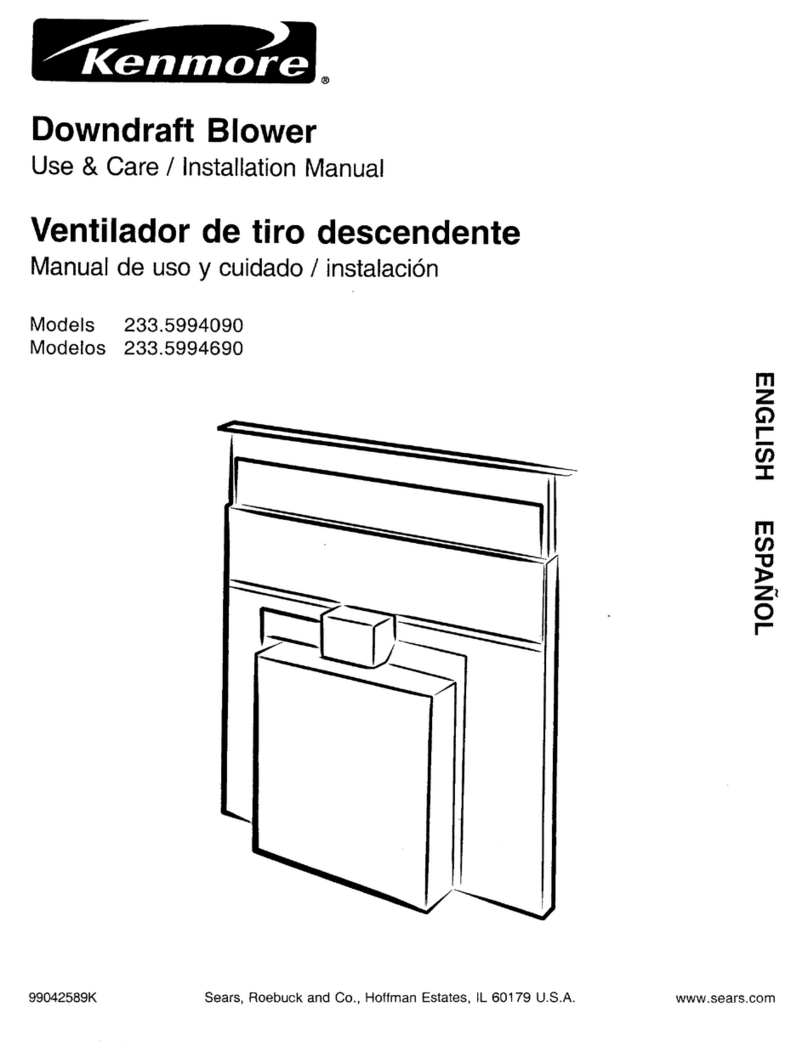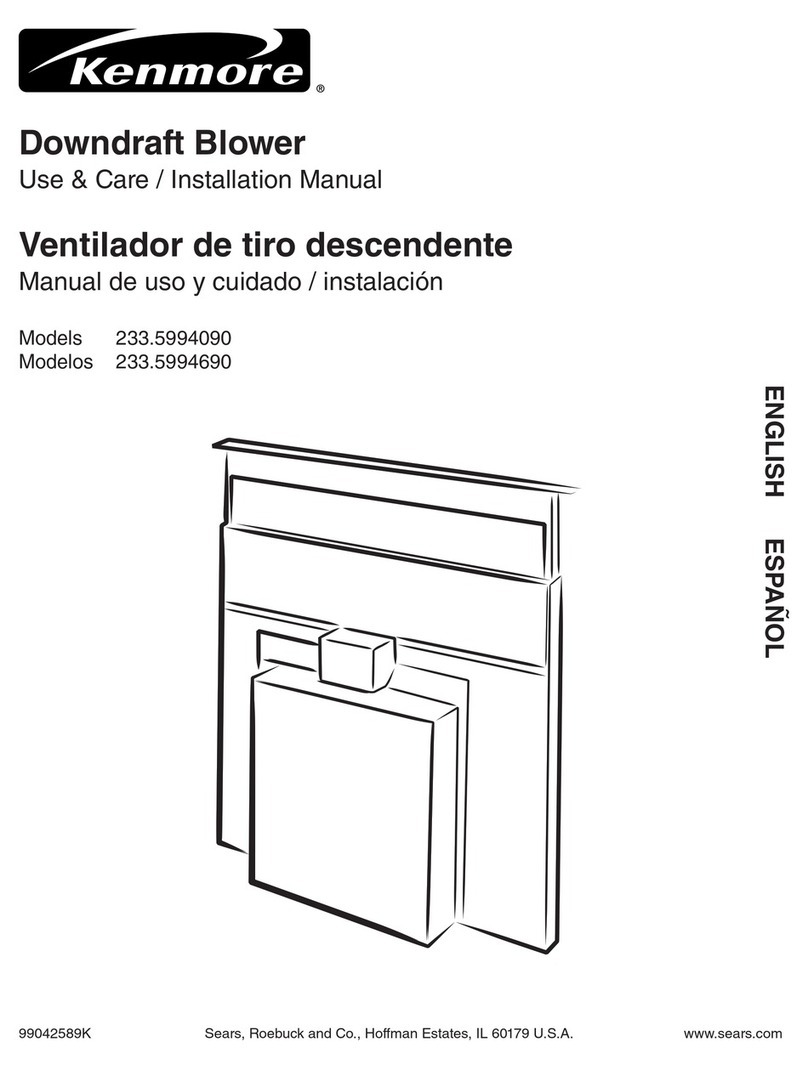
3
OPERATION
Warranty Safety CleaningOperation Installation Service Parts
Always turn the downdraft blower on before you begin cooking
to establish an air ow in the kitchen. Let the blower run for a few
minutes to clean the air after you turn the cooktop o. This will
keep the whole kitchen cleaner and brighter.
CONTROLS
NOTE
For most convenient operation, set the blower to your favorite
speed. The blower will come on to this speed whenever the
activating switch is pressed and the air vent rises.
HEAT SENTRY
When chimney is UP and blower is ON (at any speed) or OFF:
If the exhaust temperature becomes higher than expected, the Heat
Sentry mode will activate and increase the blower speed to HIGH.
Lowering the chimney will turn blower OFF - even if Heat Sentry
is active.
WARNING
TO REDUCE THE RISK OF FIRE, ELECTRIC SHOCK, OR INJURY TO PER-
SONS, OBSERVE THE FOLLOWING:
1. Use this unit only in the manner intended by the manufacturer. If you
have questions, contact the manufacturer at the address listed in the
warranty.
2. Before servicing or cleaning unit, switch power o at service panel
and lock the service disconnecting means to prevent power from being
switched on accidentally. When the service disconnecting means cannot
be locked, securely fasten a prominent warning device, such as a tag,
to the service panel.
3. Installation work and electrical wiring must be done by a qualied
person(s) in accordance with all applicable codes and standards,
including re-rated codes and standards.
4. Sucient air is needed for proper combustion and exhausting of
gases through the ue (chimney) of fuel burning equipment to prevent
backdrafting. Follow the heating equipment manufacturer’s guideline and
safety standards such as those published by the National Fire Protection
Association (NFPA), and the American Society for Heating, Refrigeration
and Air Conditioning Engineers (ASHRAE), and the local code authorities.
5. When cutting or drilling into wall or ceiling, do not damage electrical
wiring and other hidden utilities.
6. Do not use this unit with an additional speed control device.
7. Ducted fans must always be vented to the outdoors.
8. To reduce the risk of re, use only metal ductwork.
9. Do not install this product with the activating switch directly behind a
burner or element. Minimum distance between the switch and the edge
of the burner should be 4 inches.
10. Loose-tting or hanging clothing should never be worn when operating
this appliance. They may be ignited by burners/elements on cooktop.
11. Children should not be left alone or unattended in the area where this
appliance is in use.
12. This unit must be grounded.
TO REDUCE THE RISK OF A RANGE TOP GREASE FIRE:
1. Never leave surface units unattended at high settings. Boilovers cause
smoking and greasy spillovers that may ignite. Heat oils slowly on low
or medium settings.
2. Always turn hood ON when cooking at high heat or when cooking
aming foods.
3. Clean ventilating fans frequently. Grease should not be allowed to
accumulate on fan or lter.
4. Use proper pan size. Always use cookware appropriate for the size of
the surface element.
TO REDUCE THE RISK OF INJURY TO PERSONS IN THE EVENT OF A
RANGE TOP GREASE FIRE, OBSERVE THE FOLLOWING:*
1. SMOTHER FLAMES with a close-tting lid, cookie sheet, or metal
tray, then turn o the burner. BE CAREFUL TO PREVENT BURNS. If the
ames do not go out immediately, EVACUATE AND CALL THE FIRE
DEPARTMENT.
2. NEVER PICK UP A FLAMING PAN - You may be burned.
3. DO NOT USE WATER, including wet dishcloths or towels - a violent steam
explosion will result.
4. Use an extinguisher ONLY if:
A. You know you have a Class ABC extinguisher and you already know
how to operate it.
B. The re is small and contained in the area where it started.
C. The re department is being called.
D. You can ght the re with your back to an exit.
* Based on “Kitchen Firesafety Tips” published by NFPA.
CAUTION
1. For general ventilating use only. Do not use to exhaust hazardous or
explosive materials and vapors.
2. To avoid motor bearing damage and noisy and/or unbalanced impellers,
keep drywall spray, construction dust, etc. o power unit.
3. Clean lters and grease-laden surfaces frequently.
4. Do not repair or replace any part of this appliance unless specically
recommended in this manual. All other servicing should be done by a
qualied technician.
5. Please read specication label on product for further information and
requirements.
SAFETY INSTRUCTIONS
INTENDED FOR DOMESTIC COOKING ONLY
Turn the downdraft blower ON by pressing down on the activating
switch. The air vent will rise.
The blower can be turned ON or OFF and its speed can be adjusted
with the recessed knob on the right side of the air vent.
Turn the downdraft blower OFF by pressing the activating switch
again. The air vent will go down and the blower will shut OFF.





























